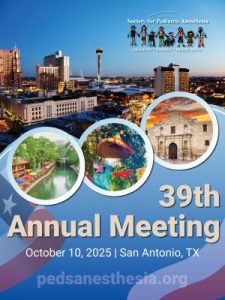{“questions”:{“ktby8”:{“id”:”ktby8″,”mediaType”:”image”,”answerType”:”text”,”imageCredit”:””,”image”:”https:\/\/pedsanesthesia.org\/wp-content\/uploads\/2023\/02\/Picture3.jpg”,”imageId”:”6694″,”video”:””,”imagePlaceholder”:””,”imagePlaceholderId”:””,”title”:”During an inhalational induction, a previously healthy 7-year-old boy develops an abnormal rhythm as shown on the telemetry strip. Vital signs are HR 220 BPM, RR 23, SpO2<\/sub> 89% on 100% oxygen and non-invasive BP 60\/35 mmHg. There is no intravenous (IV) access. Which of the following is the MOST appropriate intervention? “,”desc”:””,”hint”:””,”answers”:{“31x3g”:{“id”:”31x3g”,”image”:””,”imageId”:””,”title”:”A.\tAdminister 20mL\/kg fluid bolus”},”qvw04″:{“id”:”qvw04″,”image”:””,”imageId”:””,”title”:”B.\tPerform a synchronized cardioversion with 0.5 J\/kg”,”isCorrect”:”1″},”u08q8″:{“id”:”u08q8″,”image”:””,”imageId”:””,”title”:”C.\tAdminister 0.1mg\/kg adenosine”},”tf8n6″:{“id”:”tf8n6″,”image”:””,”imageId”:””,”title”:”D.\tPlace an ice-cold wet cloth on the patient\u2019s face”}}}},”results”:{“5nygs”:{“id”:”5nygs”,”title”:””,”image”:””,”imageId”:””,”min”:”0″,”max”:”1″,”desc”:””,”redirect_url”:”https:\/\/pedsanesthesia.org\/wp-content\/uploads\/2023\/02\/Week-127-Atrial-Tachycardias.pdf”}}}
Question of the Week #126
{“questions”:{“lue4f”:{“id”:”lue4f”,”mediaType”:”image”,”answerType”:”text”,”imageCredit”:””,”image”:””,”imageId”:””,”video”:””,”imagePlaceholder”:””,”imagePlaceholderId”:””,”title”:”An ex-26 week male is diagnosed with retinopathy of prematurity. Which of the following is MOST likely to have contributed to this? “,”desc”:””,”hint”:””,”answers”:{“e0dkf”:{“id”:”e0dkf”,”image”:””,”imageId”:””,”title”:”A.\tHyperoxia”,”isCorrect”:”1″},”cqxz0″:{“id”:”cqxz0″,”image”:””,”imageId”:””,”title”:”B.\tHigh birth weight”},”dta5c”:{“id”:”dta5c”,”image”:””,”imageId”:””,”title”:”C.\tHypertension”},”649k2″:{“id”:”649k2″,”image”:””,”imageId”:””,”title”:”D.\tAlkalosis”}}}},”results”:{“3hffw”:{“id”:”3hffw”,”title”:””,”image”:””,”imageId”:””,”min”:”0″,”max”:”1″,”desc”:””,”redirect_url”:”https:\/\/pedsanesthesia.org\/wp-content\/uploads\/2023\/01\/Week-126-Retinopathy-of-Prematurity.pdf”}}}
Question of the Week #125
{“questions”:{“j3tzy”:{“id”:”j3tzy”,”mediaType”:”image”,”answerType”:”text”,”imageCredit”:””,”image”:””,”imageId”:””,”video”:””,”imagePlaceholder”:””,”imagePlaceholderId”:””,”title”:”Which of the following hepatic enzymes involved in drug metabolism is MOST mature in a term newborn? “,”desc”:””,”hint”:””,”answers”:{“3fdsx”:{“id”:”3fdsx”,”image”:””,”imageId”:””,”title”:”A.\tCytochrome P450″},”8vayh”:{“id”:”8vayh”,”image”:””,”imageId”:””,”title”:”B.\tGlucuronosyltransferase”},”2zm4m”:{“id”:”2zm4m”,”image”:””,”imageId”:””,”title”:”C.\tSulfotransferase”,”isCorrect”:”1″},”gxear”:{“id”:”gxear”,”image”:””,”imageId”:””,”title”:”D.\tN-acetyltransferase”}}}},”results”:{“13x5d”:{“id”:”13x5d”,”title”:””,”image”:””,”imageId”:””,”min”:”0″,”max”:”1″,”desc”:””,”redirect_url”:”https:\/\/pedsanesthesia.org\/wp-content\/uploads\/2023\/01\/Week-125-Development-of-Hepatic-Function.docx.pdf”}}}
Question of the Week #124
{“questions”:{“h58hi”:{“id”:”h58hi”,”mediaType”:”image”,”answerType”:”text”,”imageCredit”:””,”image”:””,”imageId”:””,”video”:””,”imagePlaceholder”:””,”imagePlaceholderId”:””,”title”:”Polymorphisms in which of the following cytochrome P450 systems mediates the variable patient nociceptive response to codeine?”,”desc”:””,”hint”:””,”answers”:{“r48ln”:{“id”:”r48ln”,”image”:””,”imageId”:””,”title”:”A.\tCYP3A4″},”guwor”:{“id”:”guwor”,”image”:””,”imageId”:””,”title”:”B.\tCYP2D6″,”isCorrect”:”1″},”3kycz”:{“id”:”3kycz”,”image”:””,”imageId”:””,”title”:”C.\tCYP2E1″},”b7ivu”:{“id”:”b7ivu”,”image”:””,”imageId”:””,”title”:”D.\tCYP2C9″}}}},”results”:{“rcgsn”:{“id”:”rcgsn”,”title”:””,”image”:””,”imageId”:””,”min”:”0″,”max”:”1″,”desc”:””,”redirect_url”:”https:\/\/pedsanesthesia.org\/wp-content\/uploads\/2023\/01\/Week-124-Cytochrome-P450-and-Polymorphisms.docx.pdf”}}}
Question of the Week #123
{“questions”:{“08ymi”:{“id”:”08ymi”,”mediaType”:”image”,”answerType”:”text”,”imageCredit”:””,”image”:””,”imageId”:””,”video”:””,”imagePlaceholder”:””,”imagePlaceholderId”:””,”title”:”A 2-year-old boy presents for bronchoscopy to remove an airway foreign body. He has a full stomach. He is currently sitting in bed with unlabored breathing and able to speak in full sentences. Which of the following airway foreign bodies MOST urgently requires removal?”,”desc”:””,”hint”:””,”answers”:{“kcrvm”:{“id”:”kcrvm”,”image”:””,”imageId”:””,”title”:”A.\tCopper coin”},”mgfz3″:{“id”:”mgfz3″,”image”:””,”imageId”:””,”title”:”B.\tLEGO\u00ae piece”},”afprz”:{“id”:”afprz”,”image”:””,”imageId”:””,”title”:”C.\tTooth “},”n600t”:{“id”:”n600t”,”image”:””,”imageId”:””,”title”:”D.\tUnroasted peanut”,”isCorrect”:”1″}}}},”results”:{“h9yl3”:{“id”:”h9yl3″,”title”:””,”image”:””,”imageId”:””,”min”:”0″,”max”:”1″,”desc”:””,”redirect_url”:”https:\/\/pedsanesthesia.org\/wp-content\/uploads\/2023\/01\/Week-123-Airway-Foreign-Body.pdf”}}}
- « Previous Page
- 1
- …
- 27
- 28
- 29
- 30
- 31
- …
- 46
- Next Page »
